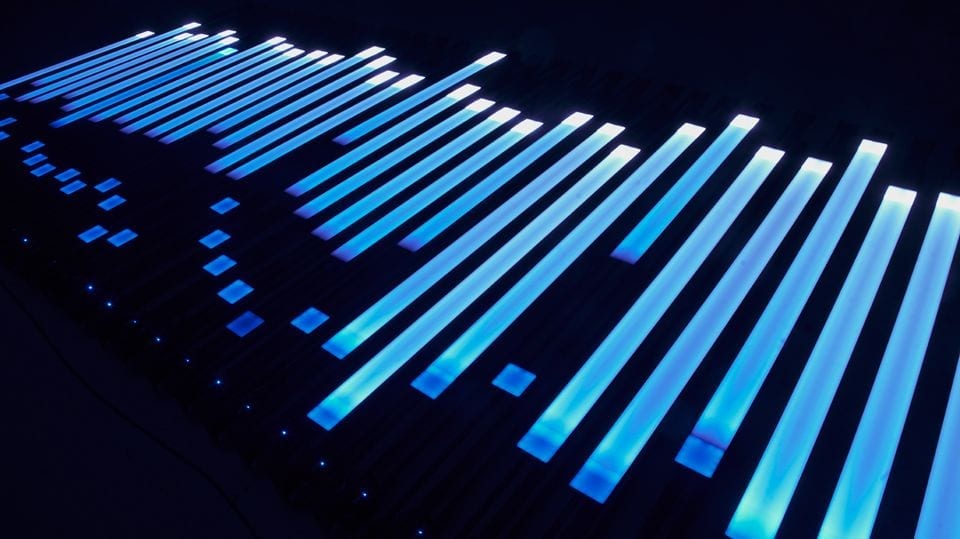We live in an increasingly post-produced world. The reuse, reinterpretation and reediting of existing information is the ascendant modus operandi for contemporary forms of (cultural) production. Yet, given that (whether for legal, or aesthetic reasons) this cultural postproduction is often undeclared, the extent to which it has pervaded culture can be hard to recognise and thus difficult to rigorously examine. However, understanding what it is – and how it takes place – is an urgent task for those eager to safeguard their agency in a world of rapid technological change.
In his book Postproduction: Culture as Screenplay, Nicholas Bourriaud observes that: “Since the early the nineties, an ever-increasing number of artworks have been created on the basis of preexisting works; more and more artists interpret, reproduce, reexhibit, or use works made by others or available cultural products. […] The material they manipulate is no longer primary. It is no longer a matter of elaborating a form on the basis of a raw material but working with objects that are already in circulation on the cultural market, which is to say, objects already informed by other objects.”¹
Bourriaud’s observations anticipated the emergence of what is now known as remix studies – an international movement that began around the late nineties, and which is closely linked to open source and do-it-yourself activities that became relevant on the Internet around that time.²

As a practice, remix was first made popular in music communities (such as disco and hip hop) in the 1970s, but it has its roots in antecedent eras. Indeed, one might even venture to say that (perhaps since the inducement of Dionysian imitatio) postproduction / remix has always dominated the process (if not the discourse) of art. Art history is now widely accepted as one of reinterpretations, appropriations, cross references, dialogic presuppositions and citations – from cubist collages and situationist détournement, to modernist cut-up techniques and postmodernist culture jamming.
Yet, contemporary postproduction occurs within a context that renders it radically different from historic forms of appropriation. Increased access, rapid transmission and democratised production all mean that today’s postproduction art reflects the proliferating chaos of global culture in the information age – a chaos that collides together everything (whether intentionally or not) and seems exponential; the network ensures that postproduction is compound – with citations standing on the shoulders of citations. Consequently, we see the eradication of the traditional distinction between production and consumption, creation and copy, readymade and original work, moving beyond a simple “art of appropriation”, which naturally infers an ideology of ownership, and instead towards a culture of constant activity based on a collective ideal: sharing.

Yet, precisely how this information is gathered together, combined and reformatted has not been rigorously interrogated; the application of postproduction techniques to culture today (in the most general sense) is a process that awaits systematic study. More careful consideration needs to be given to the ways in which borrowing and amalgamating have been, and can be, a source of cultural innovation; only then will it be possible to reflect on the value of different postproduction approaches and, in turn, answer the question: how should we bring together the heterogeneous elements of existence that history offers? Or, in other words, how should we post-produce our world?
If one looks closely at this hegemony of borrowing and copying, it becomes apparent that postproduction poses a series of unique challenges for art, design and architecture – challenges which are less to do with what is occurring (although this does raise important questions regarding authenticity, reception, authorship and copyright), and more to do with how it is taking place.
Within the film and media industries, postproduction traditionally meant synching, mixing, editing, colour correction, and other procedures performed after principal shooting. With digital technologies, these processes have accelerated substantially; in recent years, postproduction has begun to take over production wholesale. Fewer and fewer components actually need to be shot because they are partially or wholly created in postproduction. However, whilst some of these techniques are certainly employed by filmmakers in order to create scenes that would not be possible in the real world, more often than not the decision to postproduce is in fact driven by economic imperatives. It is simply cheaper to do it in the machine than on location.
As Hito Steyerl has acknowledged, forms of montage that we are accustomed to in the cinema are derived from economic necessities, despite masquerading as storytelling devices. Even parallel montage – the narration of two strands of the story in parallel, which became universal as early as 1909 – is the product of an economic logic in which “it is cheaper and more efficient in terms of production because one doesn’t need to shoot chronologically.”³ As such, the tools of postproduction available to us today are those that, under our current capitalist ideology, we have collectively chosen to develop. The computer screen of the postproduction artist, therefore, provides a black mirror that reflects society’s values at large.

To understand that postproduction decisions are invariably led by dominant cultural and economic ideologies is important when considering that today, the vast majority of postproduction acts are being performed autonomously by machines – from algorithmically generated news stories to auto-enhanced photos. We are also witnessing a proliferation of artworks which make use of automated postproduction techniques; from films like Oscar Sharp’s Sunspring (2016) – a sci-fi film written entirely by an artificially intelligent bot⁴– to the invasion of neural networks into the gallery (see The Next Rembrandt⁵, the work of artist Sascha Pohflepp⁶ or Fabrica’s IK Prize winning Recognition⁷), automated processes are increasingly dictating the terms of appropriation.
However, this form of automation – what could be referred to as a post-production of postproduction – problematises, amongst other things, the status of the artist in creative processes (and concomitantly her / his ability to intervene in the world). To wit, when control of curation / production is handed over to machines, the danger is that cultural objects simply embody the values of the capitalist society from whence they came, regardless of what their “content” happens to be.
As spatial designers (working in architecture, interior design and stage design), we find this particularly disconcerting. Today, urban space is being reframed and remade in a similar mode to film and other art forms. Software advances are providing architects with new digital tools (BIM, simulation softwares, VR, AR etc.) that bear increasing similarity to the tools of the postproduction artist. Consequently, an “architecture of postproduction” is latent within the profession – an architecture which risks complicity in the prevailing neoliberal agendas of those who shape our cities.

How, then, given the vast amounts of data that punctuate our complex society, might a manual design approach compete with the brute-force approach of automated postproduction (with all the information processing such processes entails)? Within the School of Architecture at the Royal College of Art, we have developed a postproduction manual – or a Manual for Redesigning Reality⁸– which proposes a way forward. Only by manually understanding the mechanisms by which machines are reformatting our world can we engage with, and reverse-engineer the status quo.
By breaking down various postproduction techniques into simple diagrams that translate into 3D space, the manual develops a new framework for the analysis and production of architecture. Through this analysis the manual is intended to provide a new reading of contemporary architecture – one that highlights the significance of postproduction, as well as advocates the appropriation and future use of postproduction techniques in architectural design.

This manual also maps unlikely connections between the realms of art, architecture, filmmaking and society by utilising lexical coincidences. For example, postproduction is a word from the vocabulary of audiovisual practitioners; but it could also be used to refer to an automated world that is post (or after) human production. Likewise, manual can be interpreted as both a document providing instructions or information, as well as relating to something done by hands (as opposed to automated means). This wordplay (which extends to each and every technique) is used as a means to reveal political, social, environmental or technological truths that are tacit yet significant.
Take cut: as Steyerl discusses in her essay “Cut! Reproduction and Recombination”, cut embodies a number of cultural and political meanings. In current economic terms, cut refers to a reduction, usually of government spending allocated to social services. In the language of austerity, cuts are often described in relation to the body. The state is compared to an individual whose body must lose parts or reduce in size in order to function. In cinematic terms, cuts separate shots, but also frame the body within the space of the screen, allowing it to be manipulated, parts hidden or revealed. Architectural cuts manifest in a number of ways: cutting is used to reconfigure and edit existing buildings, to join different materials, to create voids. A cut could be experienced whilst moving through the building or evident in a façade. When budgets are cut, buildings are cut also – often starting with libraries, community centres and social housing.
To return to our opening statement, if reality is postproduced, then it follows that we can also change reality through postproduction. As architects, perhaps we can “reverse photoshop” our world to create preferable, or at least alternative, realities? An architecture of postproduction as an antidote to our post-production future …
Nicola Koller, Matteo Mastandrea and Thomas Greenall
Nicola Koller, Tom Greenall and Matteo Mastrandrea collectively teach Architectural Design Studio 4 (ADS4) at the Royal College of Art in London. ADS4 is a critical design studio that explores the implications (rather than the applications) of emerging technologies on society, architecture, and the built environment through a transdisciplinary approach that brings together their individual experience in architecture, fashion, film and stage design.
References:
1. Nicolas Bourriaud (2002). Postproduction: Culture as Screenplay: How Art Reprograms the World. 7.
2. See, for example, The Routledge Companion to Remix Studies. Edited by Eduardo Navas & Owen Gallagher, (2017).
3. Hito Steyerl (2015). Cut! Reproduction and Recombination.
4. www.youtube.com/watch?v=LY7x2Ihqjmc
5. www.nextrembrandt.com
6. www.pohflepp.net/Work/Spacewalk
7. www.fabrica.it/recognition
8. Manual for Redesigning Reality by ADS4 at the Royal College of Art: www.ads4.co
Credits:
1. Nicolas K Feldmeyer, After All 2, 2015.
2. Jiayu Liu, Ocean Wave.
3. breadedEscalope, Shadowplay, 2015.
4. Helena Hamilton, Untitled (With), 2015.
5. Anna Heinrich and Leon Palmer, Strange Attractor.
6. Nicolas K Feldmeyer, After All, 2015.





